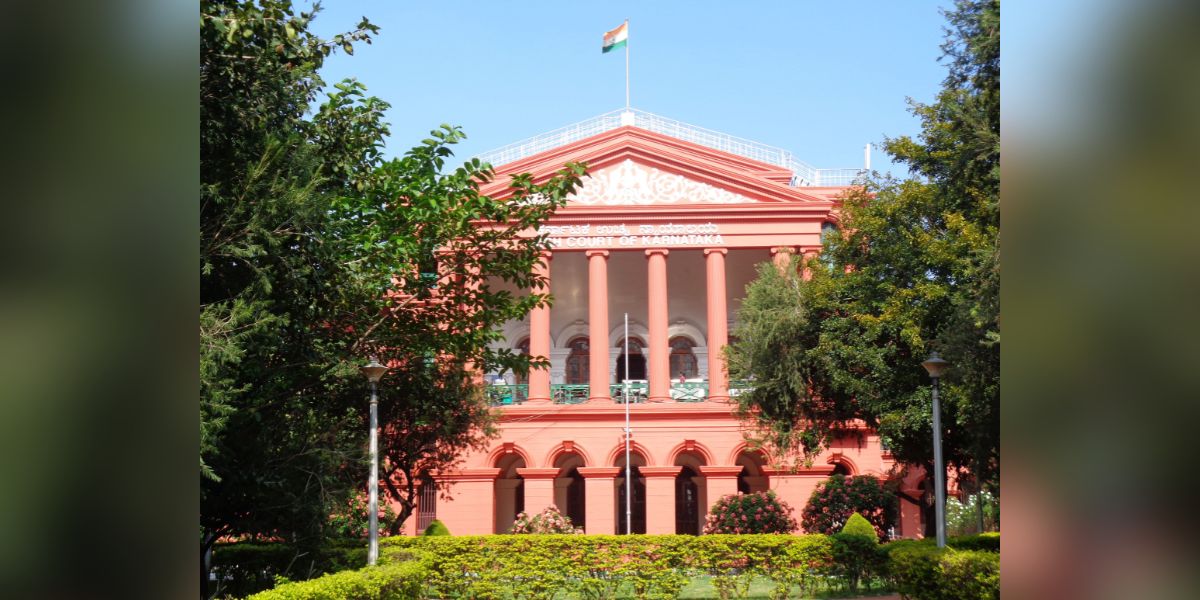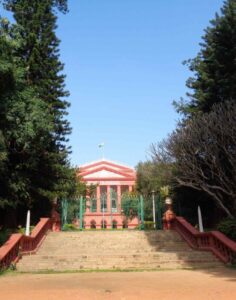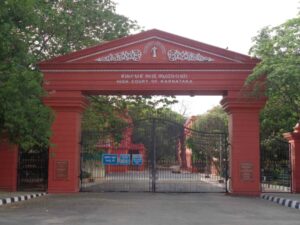The striking features of the colonial-era Karnataka High Court include Corinthian columns, pedimented windows, and the Pompeiian red colour.

Karnataka High Court building
It is not often that the building housing the Karnataka High Court receives the attention it deserves, especially since the colonial-era structure is sandwiched between the formidable and competing views of the Neo-Dravidian Vidhana Soudha on one side and the verdant Cubbon Park.
Yet, with its towering pillars, this overlooked building holds the city’s administrative history, history made as the colonial tides turned and receded.
Approaching it from Vidhana Soudha and the Court’s main entrance, the building appears to be a bee hive of black-coated advocates.
On the other side, it gazes, unfettered by the summer heat, upon Cubbon Park: awash in the season’s brightest tabebuia and gulmohar, the silent bandstand, and, still ahead, the Government Museum girdled in scaffolds and stripped of the signature red of colonial-era public buildings like the Karnataka High Court.
Some accounts say this was the original entrance of the building—the one overlooking the Park. But this suggestion is contested.
T P Issar, in his seminal book, The City Beautiful, says, “The Cubbon Park was laid out later behind the edifice to provide a suitable setting to it.”

Karnataka High Court.
Richard Sankey designed both the Park and the building during the tenures of Commissioner Lewin Bentham Bowring and, later, Commissioner John Meade.
After the British killed Tipu Sultan in 1799, they returned Bangalore to Krishnarajendra Wodeyar III. Tipu and his father, Haider Ali, the former commander of the Mysore state who had been given Bangalore as jagir, had seized power from the Wodeyars.
However, Lord William Bentick from the British Commission took administrative power from Wodeyar III in 1831. The British also moved from Srirangapatna, Tipu’s capital, to Bangalore.
Tipu’s Summer Palace housed some of the administrative departments of the princely Mysore state. The authorities realised the need for more spacious offices. They drew plans as early as 1857. However, no action was taken as India’s First War of Independence took precedence.
The Government of India rejected the initial design in 1860, delaying the proposal.
Following the mutiny, when India came under the British Crown and with a new building plan, Commissioner Lewin Bentham Bowring ordered the commencement of the building, known as the Public Offices building.
It was contracted to Wallace & Company, who subcontracted the construction to Rao Bahadur Arcot Narrainsawmy Mudaliar (of the RBANMS education institutions and charities).
Construction began in 1864 and ended in 1868. It cost around ₹3.68 lakh. Cubbon chose the site, which straddled the city area and the Cantonment.
The two-story brick-and-stone building was built in the popular Graeco-Roman style of Europe. Issar describes it as “…a structure of vast expanse with Ionic porticos at the centre and at the two ends of the elevation. It covers an area of 1.95 lakh square feet. Its situation is axially in line with the Vidhana Soudha and the State Archaeological Museum in the Park.”
The building’s striking features include Corinthian columns, pedimented windows, and the Pompeiian red colour.
In Discovering Bengaluru, Meera Iyer also points out more local architectural elements incorporated in the design of the colonial-era Karnataka High Court.
Iyer writes, “The roofing was originally called Madras roof. Other local elements used were granite for the ground floor walls and flooring and bamboo matting for the roofs of some of the verandahs.”
Richard Sankey, in his report “Offices of the Mysore Government at Bangalore” in Indian Engineering, Vol II, edited by Major A M Lang, R E, says, “…from the presence of the verandahs everywhere and, and the peculiar construction of the door adopted, (the lower portion being panel, next Venetian, upper part glazed, and above all a fan-light ventilator,) hardly a ray of direct sunlight finds its way into the building, while at the same time there is abundant light and ventilation.”

Karnataka High Court entrance.
A cluster of public buildings that arose after the Attara Kacheri and during the colonial era employ its aesthetics, from its façade and columns to its red colour, and they stand distinctive and unified by it.
The Public Offices building, also known as Bowring’s Attara Kacheri, housed the secretariat of the princely Mysore state until the 1881 Rendition when the Maharaja of Mysore regained administrative control.
Attara Kacheri, that is, eighteen departments, was in effect long before the Public Offices building was constructed. The Wodeyars from the time of Chikkadevaraja Wodeyar in the 17th century followed the style of governance of Mughal ruler Aurangazeb, which employed eighteen departments to govern a state.
The Wodeyars had purchased Bangalore from the Mughal commander Kasim Khan.
After the 1881 Rendition, Attara Kacheri housed the secretariat, High Court of Mysore, and the offices of the Mysore commissioner. The British moved to the New Public Offices next to the Mayo Hall.
In 1917, an annexe was added to the Attara Kacheri. Post-independence, another round of renovations extended the building to accommodate the court employees.
About these additions made in a mirror image of the original, Issar writes, “One wishes that the said extension was avoidable, particularly as it would use up precious space in Cubbon Park (necessitating an amendment of the Park Areas Act)…. It will in any case look better than a ‘modern-looking’ appendage would….”
After India’s independence in 1947, the Mysore state continued some stately affairs from the Attara Kacheri. Sessions of the legislative assembly were held here and at the Town Hall.
However, the second Chief Minister of Mysore state, Kengal Hanumanthaiah, spurred by nationalist sentiments, decided on a new building. He saw the Attara Kacheri building as an imperialist symbol, and he was not allowed to demolish it.
The plan for a modern two-story building was abandoned. Instead, the extravagant Neo-Dravidian Vidhana Soudha rose in 1956, standing higher than the Attara Kacheri, as intended.
The Legislature and the secretariat shifted to the copious Vidhana Soudha, and the High Court took over the Attara Kacheri. After Karnataka’s creation in 1973, it was renamed the High Court of Karnataka.
In the 1980s, the Court sanctioned an order to demolish the building. It was contested with a public interest litigation.
It was the first PIL filed in the Karnataka High Court to save a colonial-era heritage building. The order to demolish was eventually rescinded.
Instead, the building was repaired and expanded in 1985. In 2020, the High Court decided to move the equestrian statue of Sir Mark Cubbon out of its premises.
The clamour for the building’s demolition has died. Its heritage value is sealed. Meanwhile, it is business as usual in the courts as the gavels strike.
(Anuradha Prasad is a writer and editor based in Bangalore. She runs the Instagram page @knowbangalore, documenting the city’s history and heritage, and freelances as a heritage walking tour lead. Views are personal.)
(Edited by VVP Sharma)

Apr 25, 2024

Apr 23, 2024

Apr 11, 2024

Apr 10, 2024

Apr 04, 2024

Mar 22, 2024